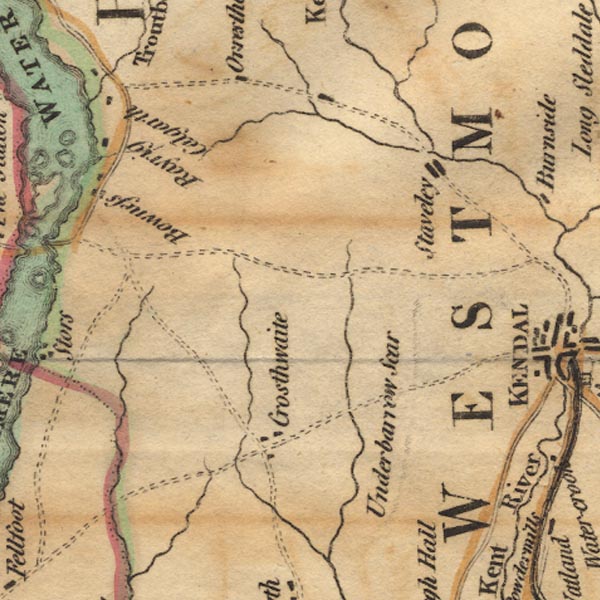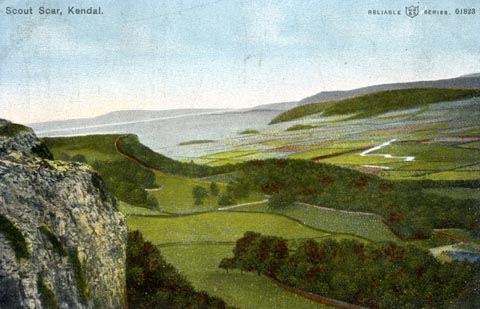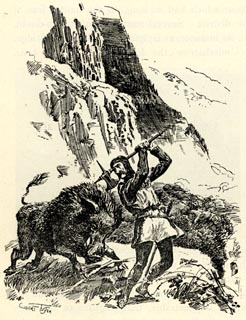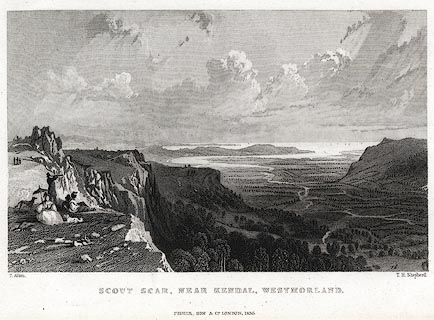





BJU89.jpg From the SW in the Lyth Valley.
(taken 12.9.2005)
placename:- Scout Scar
placename:- Underbarrow Scar

J5SD49SE.jpg
"UNDERBARROW SCAR"
hill hachuring; hill or mountain
item:- National Library of Scotland : EME.s.47
Image © National Library of Scotland
 goto source
goto sourcePage 178, footnote:- "About a mile and a half from Kendal, on the road to Ulverston, is Scout-scar, a high rock, on which is a terrace of about a mile in length, facing the west, from which there is a most extensive and surprising view, which you come upon all at once as you approach the top, and is equal, if not superior, to most of the views in this romantic country."
placename:- Underbarrow Scar

Ws02SD49.jpg
item:- Armitt Library : A1221.1
Image © see bottom of page
item:- geology; fossil; botany; flower
 goto source
goto sourceGentleman's Magazine 1794 p.112 "... The West side of the Fell [Kendal Fell] is steep, frequently perpendicular; and the great quantity of limestone rubbish collected at the bottom of the precipice is covered with underwood, and has been famous since the time of Ray for a number of uncommon plants. I can add to the list already to be found in botanical works an early and undefined variety of the cynosurus coeruleus, differing in the following particulars from that noticed by Mr. Lightfoot. It grows in the dry chinks of the rocks, flowers in the beginning of April, and never exceeds six or eight inches in height. The tevite, a kind of linnet, builds its nest on the summit, either among loose stones, or under the stinted junipers, which spread their branches over the mossy surface of this barren soil, and heighten the picture of sterility by their starved appearance. The dottrel, charadius morinellus, also pays a short visit to this uninviting spot at the first coming of the swallow, in its passage from the seacoast to the interior mountains, where it spends the summer, and lingers a few days on its return to winter-quarters about the end of September."
 goto source
goto sourceGentleman's Magazine 1794 p.112 "principally of the bivalve kind, which are very frequently mutilated. This vast mass of calcareous matter terminates in an extensive field of the same, occupying the valley to the South, In this part it rests on an elevated ridge of the grey variety of the shistus fuscus, which is the common stone of the country to the North, and even takes place immediately on the East side of the river, where no limestone appears parallel to the hill; but the natural rock is never seen in the low grounds excepting by those who sink deep wells; for, it is buried beneath a thick covering of sand and pebbles, that forms the bed of the Kent, and extends up the declivities on both sides of it to a height far exceeding the limits of the present channel. The West side of the Fell is steep, frequently perpendicular; and the great quantity of limestone rubbish collected at the bottom of the precipice is covered with underwood, and has been famous since the time of Ray for a number of uncommon plants. I can add to the list already to be found in botanical works an early and undefined variety of the cynosurus coeruleus, differing in the following particulars from that noticed by Mr. Lightfoot. It grows in the dry chinks of the rocks, flowers in the beginning of April, and never exceeds six or eight inches in height. The tevite, a kind of linnet, builds its nest on the summit, either among loose stones, or under the stinted junipers, which spread their branches over the mossy surface of this barren soil, and heighten the picture of sterility by their starved appearance. The dottrel, charadius morinellus, also pays a short visit to this uninviting spot at the first coming of the swallow, in its passage from the seacoast to the interior mountains, where it spends the summer, and lingers a few days on its return to winter-quarters about the end of September."
placename:- Scout Scar
 click to enlarge
click to enlargePH0089.jpg
printed at top:- "Scout Scar, Kendal / RELIABLE W R &S SERIES. 01823"
item:- JandMN : 957
Image © see bottom of page
item:- boar; wild boar, last
 click to enlarge
click to enlargeBGG188.jpg
Included on p.224 of Lakeland and Ribblesdale, by Edmund Bogg; an imaginative scene.
item:- JandMN : 231.88
Image © see bottom of page
placename:- Scout Scar
 click to enlarge
click to enlargePR0422.jpg
Originally vol.3 no.69 in Westmorland, Cumberland, Durham and Northumberland Illustrated.
printed at bottom left, right, centre:- "T. Allom. / T. H. Shepherd. / SCOUT SCAR, NEAR KENDAL, WESTMORLAND. / FISHER, SON &Co. LONDON, 1835."
item:- Dove Cottage : 2008.107.415
Image © see bottom of page
